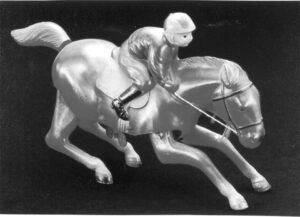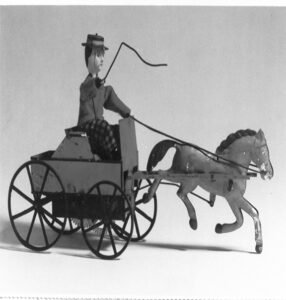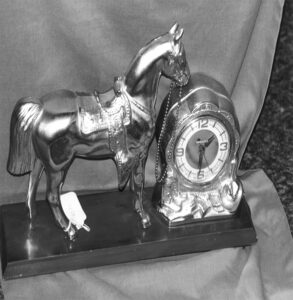 By Robert Reed
By Robert Reed While horses may not be as vital to our civilization as they once were, things which relate to them or bear their image are treasured.
High-stepping horse collectibles from clocks to weathervanes are attracting a growing number of collectors these days.
Some with a fondness for horses specialize in saddles, harness and similar riding equipment. Others seek out three-dimensional figures. Still others may center on the so-called celebrity horses like Trigger, Silver or Gene Autry’s Champion.
Additionally collectors may ride the trail specifically in search of horse-related banks, calendars, posters, puzzles, programs, toys, or even fruit crate labels.
Early 19th century weathervanes paid tribute to the horse. They were crafted from various metals, and sometimes even wood, to sit proudly atop churches, buildings and homes. Today surviving examples of the cast iron, copper, sheet metal and zinc horse weathervanes are highly prized.
 One of the noblest causes in which horses served in the 19th century was a delivery service named in their regard, The Pony Express. In 1860 a Missouri newspaper advertised for Pony Express riders this way: “Wanted. Skinny, young wiry fellows not over 18. Must be expert riders, willing to risk death daily. Orphans preferred. Wages $25 per week.”
One of the noblest causes in which horses served in the 19th century was a delivery service named in their regard, The Pony Express. In 1860 a Missouri newspaper advertised for Pony Express riders this way: “Wanted. Skinny, young wiry fellows not over 18. Must be expert riders, willing to risk death daily. Orphans preferred. Wages $25 per week.” Eventually the express service assembled 100 riders and 500 horses. The young riders were required to take an oath not to swear, fight, or abuse their horses. Then they mounted up and rode at top speed from St. Joseph, Mo., to Sacramento, Calif.—stopping only for fresh horses—to deliver mail and dispatches.
At about the same time the Pony Express ended its brief 18 months of operation, the American-based Gong Bell Manufacturing Company offered toys as a sideline to their doorbell and sleigh bell operation in Connecticut. In the years that followed they produced toy horses which rang a bell as their wheels moved. Later other U.S. companies also produced similar toys horses, some with riders, and most with bells hung to their tails.
Clearly more advanced toy horses were offered in the 1870s by the Ives, Blakeslee and Company in the United States. When wound, these horse and buggy tinplated toys would move forward and rock, while the rider’s arm would rise and fall.
 By the 1890s major catalogs, like Carl P. Stirn’s in New York City, offered scores of horse-related toys. Among them were toys of horse hide with iron wheels, tin horses complete with chimes and bells, and a wide array of cast-iron horses.
By the 1890s major catalogs, like Carl P. Stirn’s in New York City, offered scores of horse-related toys. Among them were toys of horse hide with iron wheels, tin horses complete with chimes and bells, and a wide array of cast-iron horses. Elsewhere the endearing horse was featured on wonderfully lithographed cigar labels while the Harper’s Weekly proclaimed the sport of harness racing. Unique cigar brands like Jockey Club, Derby King, Hoplah Chasters, Grand Circuit and Pacer paid tribute not only to the popular racing sport of the 1880s and 1890s but to the horse as well.
Many more fine cast iron toy horses were being produced early in the 20th century. Besides basic toys, there were horse-image banks manufactured by A.C. Williams, Arcade and others. During the 1920s and 1930s the Hubley Manufacturing Company crafted heavy metal horses which served as trusty doorstops, and still others which were crafted as bookends.
For the most part the doorstops, while impressive, were not made to represent any particular horse. There were exceptions however, in the late 1930s the Rife-Loth Corporation produced a bronze image of King’s Genius with the distinguished name along side of it.
During that period, and for part of the next decade especially inspiring horse-image bookends were also produced by such firms as the H.J. Judd Manufacturing Company and Frankart Company as well as the prolific Hubley company.
Just as horses had been richly illustrated in cigar labels of the latter 19th century, they were also celebrated in the fruit crate art of the 1920s and 1930s. During that time colorfully lithographed labels were essential to the on-site sale of fruits and vegetables in most markets. Thus the most distinguished label often attracted the greatest number of wholesale dealers.
Among the many produce brands which featured the horse in a prominent role on their labels were White Horse Grapes, Bronco Oranges, Mustang Vegetables, Pinto Vegetables and Rider Grapefruit.
During the 1940s the war years created severe shortages of most raw materials and the vast majority of America’s industrial output was directed toward the war effort. But the image of horses did not completely disappear. The Beswick Company, for example, produced some of the finest ceramic horses, foals and ponies of the 20th century.
In 1942, The Pottery Gazette and Glass Trade Review noted that Beswick’s remarkable wares that year included “a host of splendidly modeled and life-like animal subjects, including some particularly fine horses and foals—both hunters and shires (draft horses)…This being a type of potting for which the firm has established a big reputation.”
In that decade and the one that followed it, Beswick featured a wide array of horse figures including a Shetland pony, Palomino, Pinto and others. Horses were also depicted in various activities including prancing, jumping and feeding. Through the years Beswick produced more than 100 different ceramic horses. The practice continued even after the firm was acquired by Royal Doulton in 1969.
Prior to World War II toy horses were still manufactured in abundance both in the United States and in foreign countries. Various materials were used, but a major factor in the marketplace were the celluloid wind-up and celluloid stationary toy horses manufactured in Japan. These colorful and relatively durable toys heavily exported to England and the United States during the 1930s.
During the 1950s celebrity horses came to fame.
These were the faithful horse companions of movie cowboy stars such as Gene Autry and Roy Rogers, or such fictional heroes as the Lone Ranger. Ultimately the horses were so popular they were even featured in their own spin-off comic book, which sold to children by the millions. Trigger appeared on lunch boxes too, along with Roy Rogers and Dale Evans.
The Marx toy company delighted youngsters in the 1950s with Roy Rogers western play sets which, not surprisingly, included plastic horses. One harnessed pair pulled Roy’s chuck wagon. The Stanley Toy Company tried to turn back the clock with a cast iron surrey complete with cloth top and two horses. Meanwhile the Wolverine Toy Company offered a plastic horse with sulky racer as the decade ended. Marx’s Johnny West series was responsible some of most charming toy horses of the 1960s. Johnny West rode Thunderbolt, Jane West rode Buckskin. Other named horses from Marx during that period included Pancho, Storm Cloud and Commanche. Typically these 12-inch horses came with highly detailed vinyl equipment.
The lore of the horse can also be found in paper collectibles. Popular magazines which used famous artists to depict horses on covers are growing in appeal. Moreover there are older issues horse-specific magazines such as Western Horseman, Saddle and Bridle, Arabian Times and Paint Horse Journal are now attracting interest for their artful early design and contents.
Certainly the area of horse collectibles is highly varied today, and just as appealing to many as it is varied.
Recommended reading: “500 Collectible Horses, 2nd edition,” by Jan Lindenberger. (Schiffer Publishing).















Follow Us